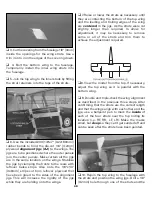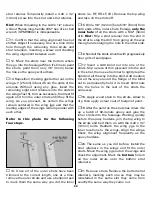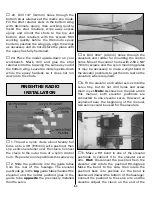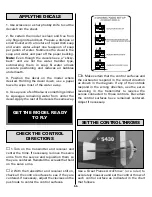
engines, the Dynaflite S.E.5a is similarly nimble
with a good climb rate and the ability to
perform many classic dog-fighting maneuvers
including loops, rolls, spins, stall turns,
Immelman turns, etc.
When you’re ready to fly, it would be a good
idea to have an assistant on the flight line with
you for reassurance and to keep an eye on
other air traffic. Tell him to remind you to
throttle back once the plane gets to a
comfortable altitude. While full throttle is
usually desirable for takeoff, most models fly
more smoothly at reduced speeds. Take it easy
with the S.E.5a for the first few flights,
gradually getting acquainted with it as you gain
confidence. Adjust the trims to maintain
straight and level flight. After flying around for
a while, and while still at a safe altitude with
plenty of fuel, practice slow flight and execute
practice landing approaches by reducing the
throttle to see how the model handles at slower
speeds. Add power to see how she climbs as
well. Continue to fly around, executing various
maneuvers and making mental notes (or having
your assistant write them down) of what trim or
C.G. changes may be required to fine tune the
model so it flies the way you like. Mind your
fuel level, but use this first flight to become
familiar with your model before landing.
Unless experienced and confident in your
ability to control a model in crosswinds, it is
strongly recommend that your first flights with
the S.E.5a are in calm conditions or when the
winds are parallel with the runway. Without
crosswinds, the S.E.5a lands beautifully–just
the same as any other model. However, in a
crosswind the model must be “cross-
controlled” so that its heading and trajectory
are parallel with the runway. For example, if
there were a crosswind coming from the left,
right rudder and left aileron would have to be
applied to counter the crosswind and keep the
model heading straight down the runway. If the
wheels are not going straight when the model
touches down it may ground loop. If you’re not
comfortable doing these “slip” landings,
practice in non-windy conditions or have an
experienced pilot assist you.
One final note about flying your model. Have a
goal or flight plan in mind for every flight. This
can be learning a new maneuver(s), improving
a maneuver(s) you already know, or learning
how the model behaves in certain conditions
(such as on high or low rates). This is not
necessarily to improve your skills
(though it is
never a bad idea!), but more importantly so you
do not surprise yourself by impulsively
attempting a maneuver and suddenly finding
that you’ve run out of time, altitude or airspeed.
Every maneuver should be deliberate, not
impulsive. For example, if you’re going to do a
loop, check your altitude, mind the wind
direction (anticipating rudder corrections that
will be required to maintain heading),
remember to throttle back at the top, and make
certain you are on the desired rates (high/low
rates). A flight plan greatly reduces the chances
of crashing your model just because of poor
planning and impulsive moves.
Remember to
think.
Have a ball! But always stay in control and
fly in a safe manner.
GOOD LUCK AND GREAT FLYING
LANDING
63
Summary of Contents for Dynaflite S.E.5a
Page 9: ...9 Die Drawing...
Page 10: ...10 Die Drawing...
















